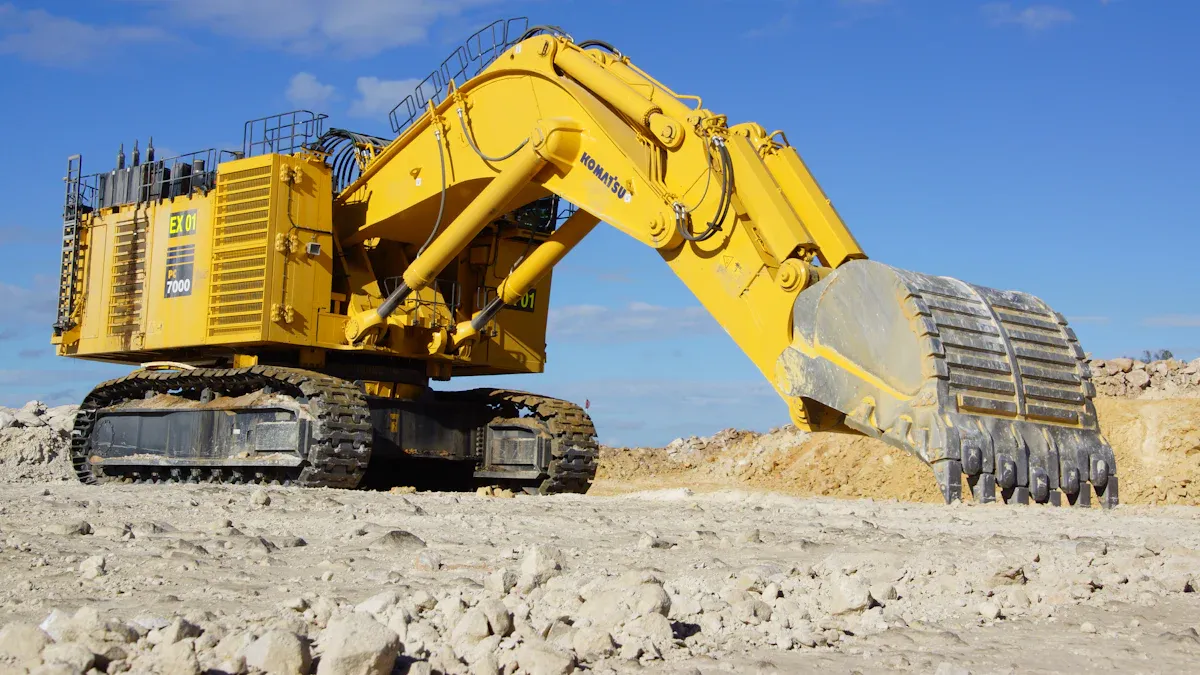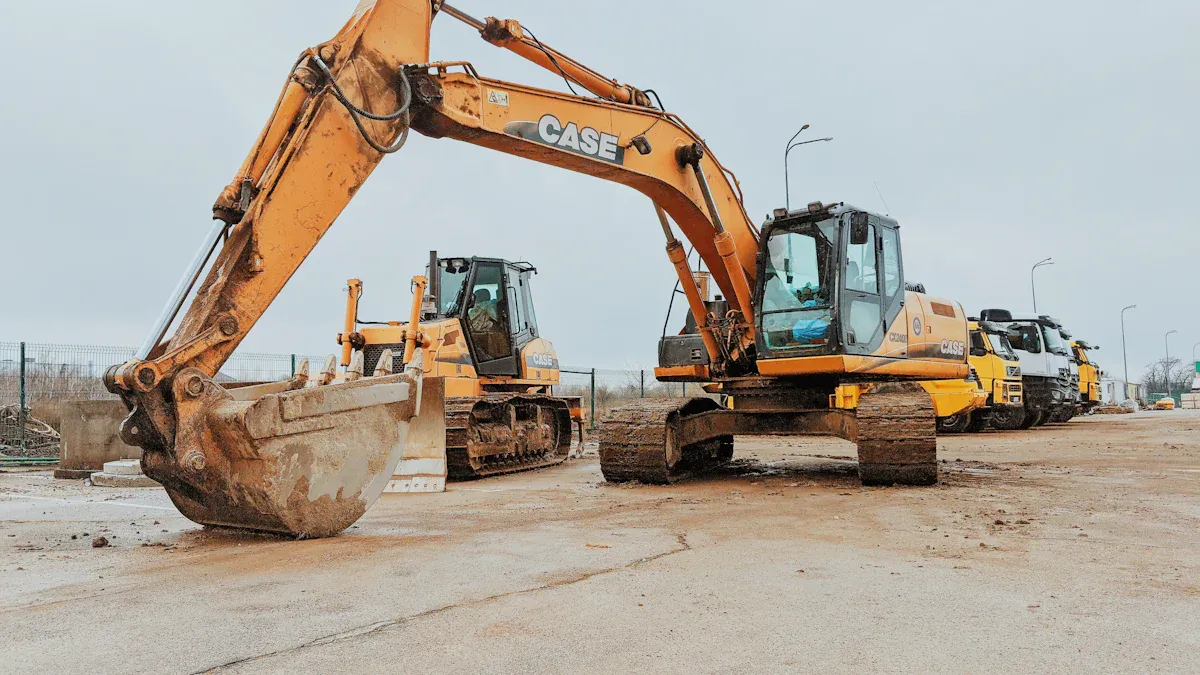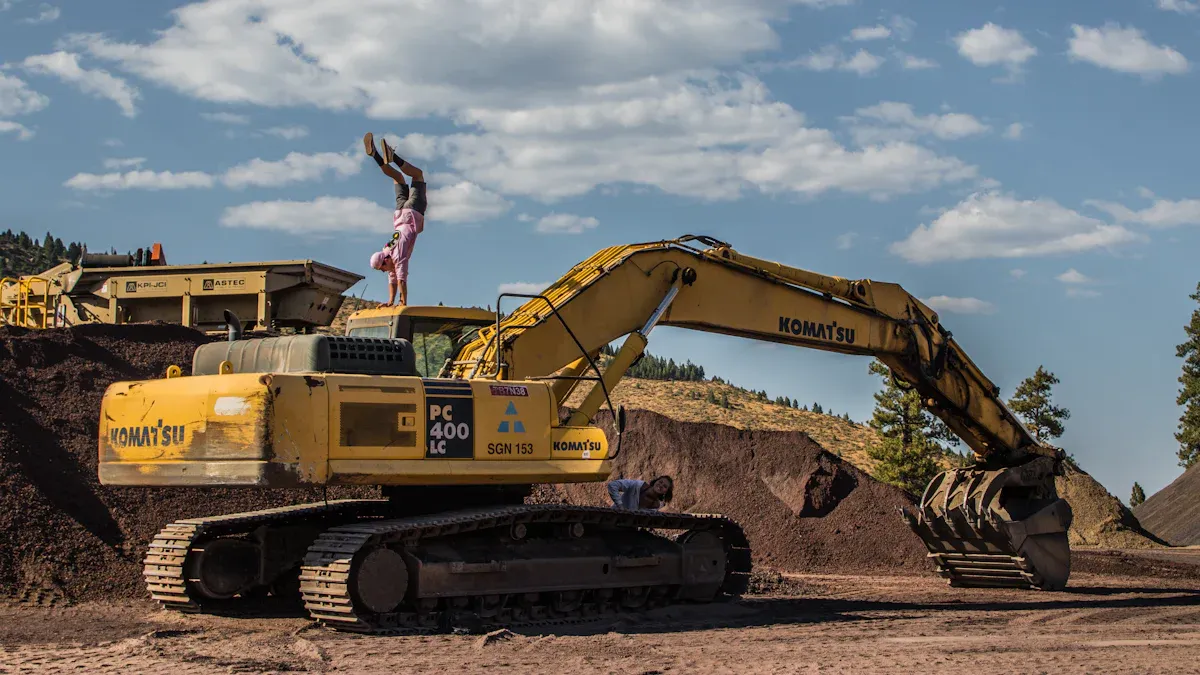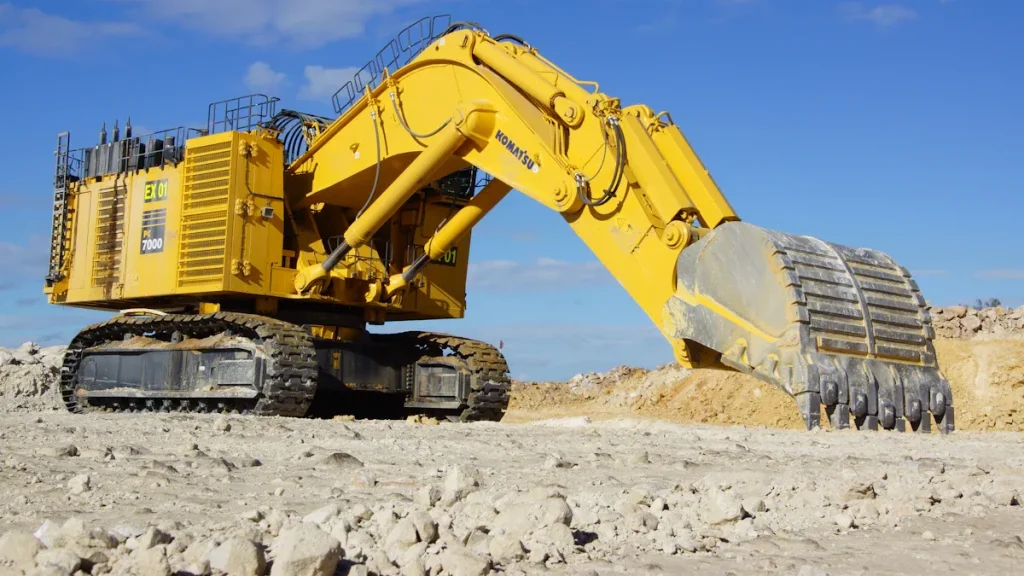
An excavator is a powerful machine designed for digging, lifting, and moving materials in construction and excavation projects. Its versatility makes it essential for tasks like demolition, grading, and material transportation. Whether you’re working on a small residential project or a large-scale mining operation, the excavator’s components and functions adapt to meet your needs.
Understanding the excavator main parts is crucial for efficient operation. The cab, for instance, houses controls that allow precise movements, while ergonomic designs enhance comfort during long hours of use. Regular maintenance of the basic parts of an excavator prevents costly breakdowns, ensuring smooth performance and reduced downtime.
Key Takeaways
Knowing excavator parts helps them work better. Learn about the cab, tracks, and engine to improve how they perform.
Taking care of tracks and undercarriage parts stops big problems. Check track tightness and clean the frame to keep it steady.
Picking the right bucket makes work faster. Use the correct bucket for digging or moving materials.
Checking fluid levels often keeps the machine running well. Look at hydraulic fluid, fuel, and coolant to stop breakdowns.
Buying good parts, like from YNF Machinery, makes your excavator last longer. Strong parts mean less downtime and better work.
Undercarriage Parts of an Excavator

Tracks
Function and role in mobility and stability.
Tracks are one of the most essential parts of an excavator’s undercarriage. They provide traction and ensure the machine remains stable during operation. By distributing the excavator’s weight over a larger surface area, tracks reduce ground pressure, allowing smooth movement on soft or uneven terrain. This feature is particularly useful when navigating through muddy, sandy, or rocky areas. Tracks also prevent the excavator from sinking into weak soils, such as marshy grounds.
Maintaining proper track tension is critical for stability and efficiency. Loose tracks can cause instability on rough terrain, while overly tight tracks increase mechanical load and reduce power efficiency. You can choose between steel tracks for heavy-duty applications or rubber tracks for urban environments where minimal surface damage is required. Regular inspection of track chains, rollers, and idlers ensures optimal performance and prevents wear.
Track Frame
Structural support for the tracks and undercarriage.
The track frame forms the backbone of the excavator undercarriage. It supports all the components, including tracks, rollers, and idlers, while protecting them from debris. This structural element ensures the excavator can handle heavy loads without compromising its integrity. The frame also houses the tensioning mechanism, which keeps the tracks aligned and prevents derailment.
A well-maintained track frame enhances the durability of the excavator undercarriage. Cleaning the frame regularly and inspecting for damage helps you avoid costly repairs. The bottom guard, often part of the frame, shields critical components from rocks and other debris, ensuring smooth operation in challenging environments.
Final Drives
Power transmission to the tracks for movement.
Final drives play a crucial role in the movement of an excavator. These components transfer power from the engine to the tracks, enabling the machine to move forward, backward, or turn. Final drives consist of gears, shafts, bearings, and housing, all working together to amplify and distribute power efficiently.
The use of planetary gearing systems in final drives enhances torque, allowing the excavator to handle demanding tasks with ease. Regular inspection of these parts ensures smooth operation and prevents unexpected breakdowns. By maintaining the final drives, you can maximize the efficiency and lifespan of your excavator.
Upper Structure and Main Components of an Excavator
Cab
Operator’s control center with visibility and controls.
The cab serves as the operator’s control center, offering a clear view of the worksite and housing essential controls for operating the excavator. Modern cabs prioritize comfort and efficiency, ensuring you can work for extended periods without fatigue. Spacious designs provide ample room for movement, while advanced joystick controls allow precise handling of the machine. Features like climate control systems and ergonomic seating enhance comfort, making long shifts more manageable.
“Offering the operator a comfortable environment lessens fatigue and stress,” says Drew Kohler, marketing manager for MMD Equipment.
Customizable displays and intuitive layouts further improve usability, helping you focus on the task at hand. The cab’s ability to rotate 360 degrees ensures you maintain visibility and control, even in tight spaces.
Engine and Excavator Engine Parts by YNF Machinery
Power source for the excavator’s operations.
The engine powers all the excavator’s operations, from digging to lifting. Diesel engines are commonly used due to their high torque and efficiency. YNF Machinery provides high-quality excavator engine parts, including pistons, cylinders, and crankshafts, ensuring reliable performance. These components are designed to withstand extreme conditions, reducing downtime and maintenance costs.
The engine compartment also houses critical elements like the fuel tank and hydraulic fluid tank. Regular maintenance of these parts ensures smooth operation and prolongs the life of your excavator. By choosing durable engine parts from YNF Machinery, you can enhance your machine’s efficiency and reliability.
Counterweight
Balances the machine during heavy lifting.
The counterweight is a vital component for maintaining the excavator’s stability. Positioned at the rear of the machine, it prevents tipping when you lift heavy loads or extend the boom. Cast iron counterweights are particularly effective, offering durability and excellent balance.
Counterweights improve stability during operation.
They allow the excavator to handle heavy tasks without compromising safety.
Regular inspection of the counterweight ensures it remains securely attached and functions as intended. This simple step enhances the excavator’s stability and prevents accidents on the job site.
Fluid Tanks
Stores hydraulic fluid, fuel, and other essential liquids.
Fluid tanks play a critical role in the operation of an excavator. These tanks store the essential liquids that keep your machine running smoothly, including hydraulic fluid, fuel, and coolant. Each liquid serves a specific purpose, ensuring the excavator performs efficiently and reliably.
Hydraulic fluid is vital for powering the excavator’s hydraulic systems. It enables the movement of the boom, arm, and bucket by transmitting force through the hydraulic lines. Without sufficient hydraulic fluid, you may notice slower operations or even system failure. Regularly checking the hydraulic fluid level helps you avoid these issues.
Fuel tanks store diesel, which powers the engine. A clean and well-maintained fuel tank ensures uninterrupted operation. Contaminants in the fuel can clog injectors and reduce engine efficiency. You should inspect the fuel tank for leaks and clean it periodically to maintain optimal performance.
Coolant tanks prevent the engine from overheating. The coolant absorbs heat from the engine and dissipates it through the radiator. Maintaining the correct coolant level protects your engine from damage caused by excessive heat.
Tip: Always use the recommended fluids for your excavator model. Using the wrong type can lead to costly repairs.
To keep your fluid tanks in good condition, follow these steps:
Inspect tanks for cracks or leaks.
Refill fluids to the recommended levels.
Use high-quality fluids to enhance performance.
By maintaining the fluid tanks, you ensure your excavator operates efficiently and lasts longer. Proper care of these components reduces downtime and keeps your projects on schedule.
Front Attachment Parts of an Excavator

Boom
Primary arm for reaching and lifting.
The boom is the excavator’s primary arm, designed to provide reach and elevation for various tasks. It extends outward from the machine, allowing you to access deep excavations or high surfaces with ease. Hydraulic cylinders power the boom’s vertical movement, enabling precise adjustments in height and reach. This hydraulic system is essential for heavy lifting tasks, as it provides the strength needed to handle large loads.
The boom’s structural design includes pins and bushings that minimize friction during movement. This feature enhances efficiency and reduces wear over time. Whether you’re digging trenches, demolishing structures, or loading materials, the boom plays a central role in the excavator’s functionality. Regular inspection and lubrication of its components ensure smooth operation and longevity.
Tip: Keep the boom clean and free of debris to prevent damage to its hydraulic cylinders and joints.
Arm
Connects the boom to the bucket, extending reach.
The excavator arm, also known as the stick or dipper, connects the boom to the bucket. It acts as an extension, increasing the machine’s reach and precision. This component allows you to perform tasks in areas that are difficult to access, such as riverbeds or demolition sites. The arm’s hydraulic system provides the flexibility needed for precise digging and material handling.
Key benefits of the excavator arm include:
Increased Reach: Access hard-to-reach areas safely and efficiently.
Enhanced Versatility: Perform a wide range of tasks, from dredging to demolition.
Improved Safety: Maintain a safe distance from hazardous zones.
By maintaining the arm’s hydraulic lines and joints, you can ensure consistent performance and avoid costly repairs.
Bucket
Used for digging, scooping, and material handling.
The excavator’s bucket is the attachment at the end of the arm, designed for digging, scooping, and handling materials. Its shape and teeth allow it to penetrate soil, rock, or other materials effectively. Different types of buckets are available for specific applications:
Digging Bucket: Ideal for general-purpose digging in construction and landscaping.
Rock Bucket: Built for breaking up rocks and compact materials in quarries.
Grading Bucket: Used for leveling and profiling softer ground.
Tilt Grading Bucket: Offers flexibility for angled grading tasks.
V Bucket: Perfect for creating clean-sided drainage trenches.
Choosing the right bucket for your task enhances efficiency and reduces wear on the excavator. Regularly inspect the bucket for cracks or worn teeth to maintain its effectiveness.
Note: Always select a bucket that matches your excavator’s capacity to avoid overloading and potential damage.
Attachments
Specialized tools like grapples, breakers, and augers for specific tasks.
Excavators become even more versatile with the addition of specialized attachments. These tools allow you to tackle specific tasks efficiently, making your machine adaptable to various projects. Whether you need to break through tough materials, handle debris, or prepare foundations, the right attachment can make all the difference.
Here are some common excavator attachments and their uses:
Augers: These attachments are perfect for drilling into soil. You can use them for tasks like planting trees, installing fence posts, or creating holes for foundations. Interchangeable bits make augers versatile for different soil types.
Grapples: Acting like a claw, grapples are ideal for grabbing and moving debris. They are especially useful in demolition and recycling projects where precision and strength are required.
Compactors: These attachments use vibration to compress soil. They are excellent for preparing foundations in tight spaces where larger equipment cannot fit.
Rippers: Designed to break through hard-packed soil, rock, or ice, rippers make excavation easier. They are essential for projects in challenging terrains.
Tip: Always choose an attachment that matches your excavator’s capacity. Using the wrong tool can reduce efficiency and damage your machine.
Each attachment enhances your excavator’s capabilities, allowing you to complete tasks faster and with greater precision. Regular maintenance of these tools ensures they remain effective and safe to use. By investing in the right attachments, you can maximize the potential of your excavator and handle a wider range of projects with ease.
Note: Consult your operator’s manual to ensure proper installation and usage of attachments. This step helps prevent accidents and prolongs the life of your equipment.
The Role of Excavator Engine Assembly in Excavator Performance
Importance of a Reliable Engine Assembly
How YNF Machinery’s excavator engine assembly ensures durability and efficiency.
A reliable engine assembly is essential for your excavator’s performance. It powers every operation, from digging to lifting, ensuring smooth and efficient functionality. YNF Machinery’s excavator engine assemblies are designed to meet the demands of heavy-duty construction work. These assemblies combine durability with efficiency, allowing your machine to handle challenging tasks without frequent breakdowns.
The high-quality materials used in YNF Machinery’s engine assemblies ensure they can withstand extreme conditions. Whether you’re working in harsh weather or rugged terrains, these components maintain their performance. By reducing fuel consumption and emissions, they also help you save on operational costs while adhering to environmental standards.
Investing in a reliable engine assembly minimizes downtime and extends the lifespan of your excavator. YNF Machinery’s products undergo rigorous quality checks, ensuring you receive components that deliver consistent results. With their expertise, you can trust that your excavator will perform at its best, even under demanding conditions.
Key Components of an Excavator Engine Assembly
Overview of pistons, cylinders, crankshafts, and other critical parts.
The engine assembly acts as the heart of your excavator, generating the power needed for its operations. It includes several critical components that work together seamlessly:
Pistons: These move within the cylinders, compressing air and fuel to create combustion. This process generates the energy required to power the machine.
Cylinders: These house the pistons and provide the space for combustion to occur.
Crankshaft: This converts the pistons’ linear motion into rotational energy, which drives the excavator’s hydraulic system and other components.
Engine Block: This serves as the foundation, holding all the components together and ensuring structural integrity.
Excavator engines typically run on diesel fuel, offering high torque and efficiency. Modern engines prioritize reduced emissions and fuel consumption, making them both powerful and environmentally friendly. The size and power output of the engine vary depending on the excavator’s size and intended use.
Regular maintenance of these components ensures your excavator operates efficiently. By choosing YNF Machinery’s engine parts, you gain access to durable and high-performing components that keep your machine running smoothly.
Tip: Always follow the manufacturer’s guidelines for maintenance to extend the life of your engine assembly.
Understanding the main components of an excavator is essential for maximizing its performance and longevity. Each part, from the undercarriage to the hydraulic system, plays a critical role in ensuring stability, mobility, and precision during operation. For example, the engine powers the machine’s movements, while the bucket significantly impacts productivity by handling materials efficiently.
Investing in high-quality parts, like those offered by YNF Machinery, ensures durability and reduces downtime. Superior engine assemblies enhance performance, minimize emissions, and lower maintenance costs. By choosing reliable components, you can keep your excavator running smoothly and complete projects on time.
Tip: Regular maintenance and the use of original parts can prevent frequent breakdowns and extend your machine’s lifespan.
FAQ
What are the most important parts of an excavator to maintain regularly?
You should focus on maintaining the engine, hydraulic system, tracks, and fluid tanks. Regularly inspect these components for wear, leaks, or damage. Clean and lubricate moving parts to prevent breakdowns. Following the manufacturer’s maintenance schedule ensures your excavator operates efficiently.
Tip: Always use high-quality replacement parts to extend your machine’s lifespan.
How do I choose the right bucket for my excavator?
Select a bucket based on the task and material type. For general digging, use a standard bucket. For rocky terrain, choose a rock bucket. Grading buckets work best for leveling. Match the bucket size to your excavator’s capacity to avoid overloading.
Why is the counterweight important for excavator stability?
The counterweight prevents tipping by balancing the machine during heavy lifting. It ensures safety and stability when extending the boom or arm. Inspect the counterweight regularly to confirm it’s securely attached and functioning properly.
What fluids should I check before operating an excavator?
Check hydraulic fluid, engine oil, coolant, and fuel levels. These fluids ensure smooth operation and prevent overheating or system failure. Use the recommended fluids for your excavator model to avoid damage.
Note: Low fluid levels can lead to costly repairs and downtime.
Can I use aftermarket parts for my excavator?
Yes, aftermarket parts can be a cost-effective option. Ensure they meet or exceed OEM standards for quality and compatibility. YNF Machinery offers durable aftermarket parts that deliver reliable performance, helping you save money without compromising efficiency.
Tip: Consult your operator’s manual to verify part compatibility.





